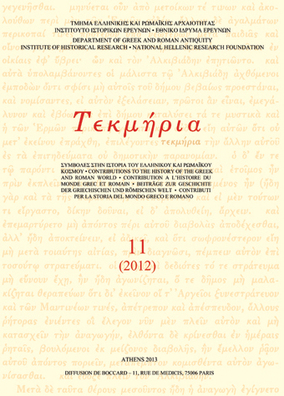Ἐνεπίγραφοι ταφικοὶ βωμοὶ ἀπὸ τὴ Θεσσαλονίκη
Part of : Τεκμήρια ; Vol.5, 2000, pages 1-34
Issue:
Pages:
1-34
Parallel Title:
Inscribed funeraly altars from Thessalonike
Section Title:
Articles
Abstract:
This article presents the editio princeps often inscribed funerary altars. Nine of them were probably found in Thessalonike (in several cases the exact conditions of the discovery and the provenance are not known); one altar was found in the village Agia Paraskevi in the vicinity of Thessalonike. One of the altars (no. 7) was known from a photograph published in the Archaiologikon Deltion (AD26 B2 ( 1971 ) [ 1975] 395, pi. 394b; cf. Bull, epigr. 1977, 273); here, we give the full text and suggest that the date follows the Actian era and that the year ςμσ ' corresponds to 214/15 A.D. Altar no. 8 also provides an exact date (160 A.D.); the other altars can be dated on the basis of the form of the monument and the letter forms. The dates range from the second quarter of the 2nd cent. A.D. to the third quarter of the 3rd cent. A.D. The study of the inscribed altars of Thessanolike enriches our knowledge of the personal names and the social history of the provincial capital and contributes to the history of art. The ten altars published here add twenty persons to the prosopography of Thessalonike. In most cases these persons have names that were already attested in inscriptions of Macedonia ('Αλέξανδρος, Άρτεμείδωρος, Γερμανός, Διονύσιος, Ερμής, Θεοδώρα, Μάρκελλος, Πρόκλα and Συρίων). The indigenous name Γουρας was less common, attested mainly in inscriptions of the pre-Roman period. The names Άτείμητος, Γαληνιανός and Χαρμόσυνος, known from other areas of the Greek world, were hitherto unattested in Thessalonike. The name Κλημέντιλλα is well known from Latin inscriptions. The name Φοιβιανή is very rare; this is true also for the name Τυχαρους (gen. Τυχαρουνος). In the case of the gentilicium Όφέλλιος used as a cognomen by Ti. Claudius Ofellios (no. 3) is suggested that it is connected with a family of Roman negotiatores (gens Ofellia). Most of the persons mentioned in these inscriptions had Roman citizenship. Naturally, the funerary altars hardly provide any information on their social position or their activities. Hermes was a freedman of C. Iulius Galenianus; Aelia Theodora and Germanos are designated as θρεπτοί; Marcellus was a banker. The general impression is that most of these persons belonged to the middle or lower social strata. This is an indication of the wide use of funerary altars in the 2nd and especially in the 3rd cent. A.D. It also confirms the impression one has from other areas of the Greek world that in this period the social position of the lower social strata (slaves and freedmen) was improved.
Subject:
Subject (LC):




